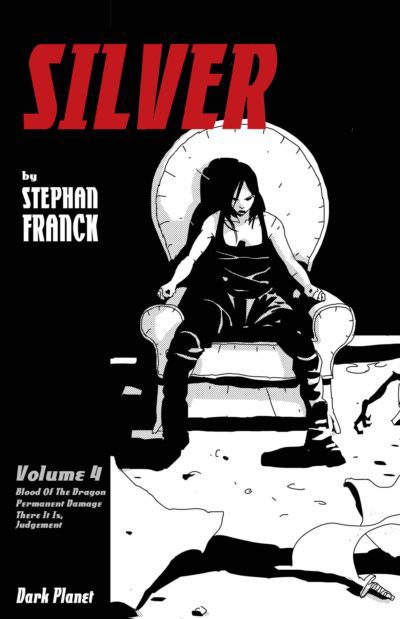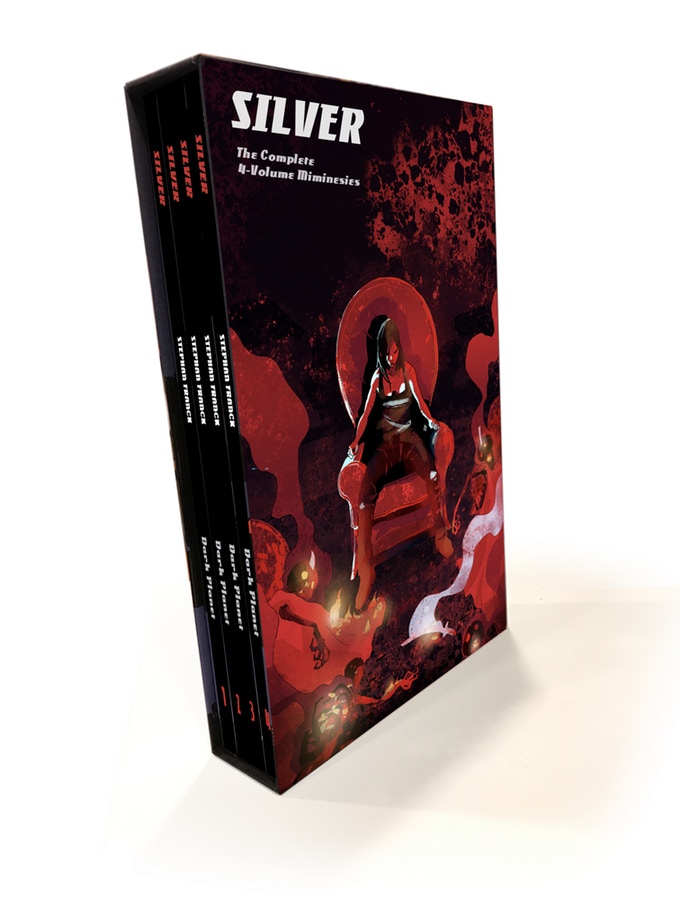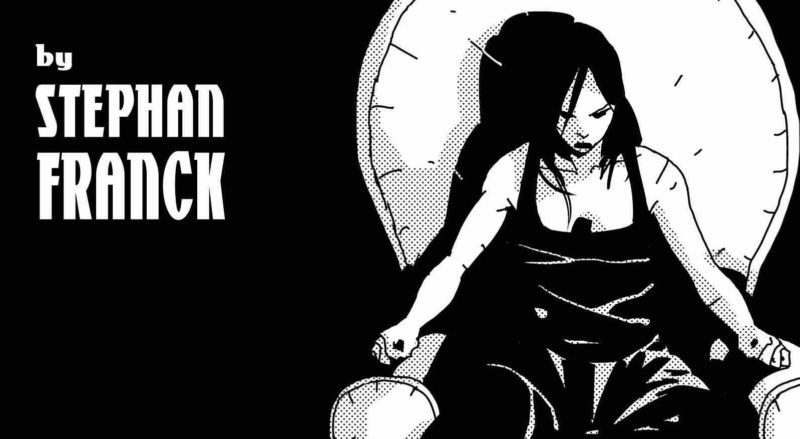INTERVIEW: Hunt for vampire treasure in ‘Silver’

Stephan Franck’s successful graphic novel, Silver, is gearing up for its fourth and final volume, but it is building a community of fans who have enjoyed this horror-filled combination of the Dracula tale with pulp elements, action and adventure. A Kickstarter campaign continues for another nine days (as of June 18), and signs look positive that readers will have a chance to see the thrilling finale. Franck has already gathered more than $13,000 on his $12,000 goal. Fanboys and fangirls can still get in on the action and earn some unique prizes along the way.
Silver, which was nominated for the Russ Manning Award, is set 40 years after Professor Abraham Van Helsing visits Dracula’s castle, a pivotal part of Bram Stoker’s original novel. This time around, Van Helsing’s descendant, Rosalynd, leads a group of con artists to steal riches from vampires around the world.
Franck is an accomplished artist with credits that run deep in the animation world. His hands have been at work on The Iron Giant, Despicable Me, Corneil & Bernie and Smurfs: The Legend of Smurfy Hollow.
Recently, Franck exchanged emails with Hollywood Soapbox and elaborated on all things pulp. Questions and answers have been slightly edited for style.
What is it about the Dracula story that inspired you to create Silver?
I have always been fascinated by vampire lore, as it is of course dark and mysterious as well as sexy and suspenseful, but it also has a very deep mythological aspect to it. The origins of vampires are lost to the sands of time, and they traverse human history with great romantic drama rooted in themes of damnation and redemption. That is also why I wanted to explore the idea of pitting vampires versus conmen, as, thematically speaking, they are very similar creatures. Both kinds’ relationship with the world is predatory, as well as one of isolation. The con men are figuratively soulless, while the vampires are literal living dead. I thought that collision would get into interesting questions about what it mean to really feel alive — is it just walking the earth for 3,000 years, or is there something more? And all that, of course, is delivered through an epic pulp romp of a rollercoaster.
In fact, I have to say that, in an odd way, although it’s steeped in vampire lore and we even do a ton of world building exploring that mythology, I never thought of Silver as strictly a vampire story. I really see it as a wild pulp adventure with vampires. When I was around 10 years old, growing up in France, we had a TV show called Midnight Cinema that aired black-and-white movies from the 1930s and ’40s ranging from Fritz Lang, to The Thin Man, to the Cagney movies, to King Kong, to the Universal monsters, to Nick Carter vs Fu Manchu. And because it was all so well curated, in my mind, it all merged into this meta world of pulp, in which you could be hanging out with gangsters in New York, catch a plane to England and be chased by a werewolf, and take a boat to a remote island where you would discover a lost civilization. So not only did it all merge in terms of the world, but also in terms of the artistic ambitions. Watching Citizen Kane back to back with Nick Carter serials creates this weird phenomenon where it all merges together, and you start feeling that you could have tons of fun with genre, while using it as a way into real characters, which is, by the way, what all the major movies are doing now. The major movies of today are based on the matinees of yesterday.
So that meta world of pulp that coalesced in my head really is the inspiration for Silver.
Did you always know that the fourth volume would be the final volume?
I did. I originally wrote the script in a movie-script format, as that is the writing form that is the most natural to me. So Silver was always a complete story with a beginning, middle [and] end. Then, as I started to lean into the visual storytelling of it, 120 pages of film script became 463 pages as a graphic novel.
As you know, most film scripts break down in four acts of equal length. Yes, people say three acts, but two is twice as long and breaks into two natural halves. So those four acts — 1, 2a, 2b and 3 — naturally organized into the series’ four volumes that had each great act structure as they followed the natural movement of a full act, each one ending with a great turn, and the [final] one, hopefully with a very strong and satisfying ending.
However, that is not to say this is the last you’ll hear of the world of Silver. In fact, we already have Rosalynd, which is an illustrated novella that is a prequel to Silver. It focuses on Rosalynd ‘Sledge’ Van Helsing, one of the series’ most popular characters, and the story is presented as her childhood’s diary. Just like Silver, it can be read as its own complete narrative, but of course, the two stories interlock tightly, and each brings another dimension to the universe.
Moving forward, you will see the Silver universe continue, but not as an endless soap or a retread of the same character arcs. It will be a complex tapestry of interconnected story, but all of them being a complete and finite narrative.

How long did it take to settle on a visual style for the graphic novel?
The visual approach to the series was always a fun blend of vintage and modernity. Being in a pulp, noir universe, and referencing those black-and-white movies I was mentioning earlier, black and white sort of became an obvious choice. I love the sense of mystery that lurks into all that black ink. There is an inherent whimsy to that type of a setting and visual approach that works great for this type of a premise.
That said, it was really important to me that the black and white didn’t look like something missing its colors. I wanted to make sure the book looked like a complete and definitive statement. That’s also why I used the zip-a-tone look, as it not only celebrates the great adventure strips of that era, but also gives a cool pop-art vibe that makes the book feel modern and pushes a strong sense of design.
Here too, it’s about infusing the vintage elements with modern sensibilities. The charm of the adventure strips is crossed with high-impact almost Kirby-like moments, but also I like to play with alternating a compressed/decompressed style of comic storytelling. I compress the tropes so we can enjoy them but don’t overstay their welcome, and decompress the original character moments or specific action/suspense moments that we want the reader to keep score on.
So all these ideas were present from the start, but like for everything, you learn by doing, and the style kept evolving and finding its comfort level the deeper I got into the story.
Is animating for the movies completely different from drawing for the comics/graphic novels?
The biggest difference is the permanence of a printed drawing. Every page remains as a definitive statement and requires some illustrative qualities. In animation, where any given drawing only stays on screen for a fraction of a second, we often say that you don’t really see the drawings. What you see is the change between the drawings. Meanwhile, in animation, the drawing is usualy more streamlined, and the focus is not as much on illustrative flourishes as it is about the specific expressions of the characters.
So I’m trying to bring that specificity of acting and ability to capture the micro moments onto the page. Animation is also great with its use of signature shapes in design. This means definitive design choices that keep a character immediately and intuitively identifiable, while hundreds of artists of various skills and who are having various kinds of drawing days are all drawings their own version of the character. That is also something I use for my comics characters.
How has Kickstarter helped your project?
The most obvious aspect is that it lets our readers pre-order the books before we print, which is very helpful, since we are completely independent. But also, there is something really incredible to see a group of people come together to shape their own cultural environment by supporting projects that they find meaningful. I think that meaningfulness is a key idea here, because we are in a very noisy and saturated culture, and people will only rally to fund things that they feel actually add to the cultural conversation.
So I’ve always been honored and humbled by the support that our Kicks have been receiving. At the end of the day, I think that’s also why the press is still covering Kickstarters — if a project out there in the wild manages to have a real grassroot life, it means that there must be something to it.
By John Soltes / Publisher / John@HollywoodSoapbox.com
Silver, by Stephan Franck, currently has a Kickstarter campaign for the fourth and final volume. Click here for more information.


“The origins of vampires are lost to the sands of time…” Not anymore! “The Vorbing” began life through crowdfunding also and is dubbed “The Vampire Creation Myth”, a “brilliantly written” origin story for vampires: getbook.at/TheVorbingAmazon